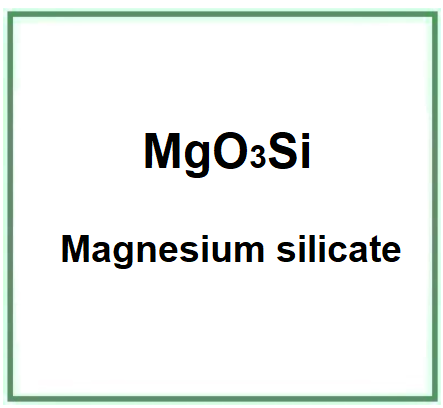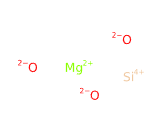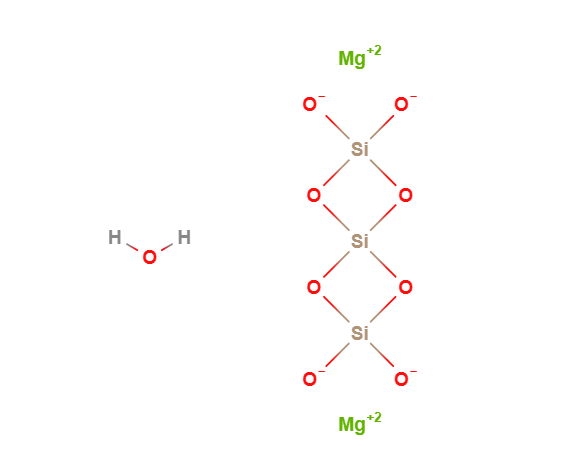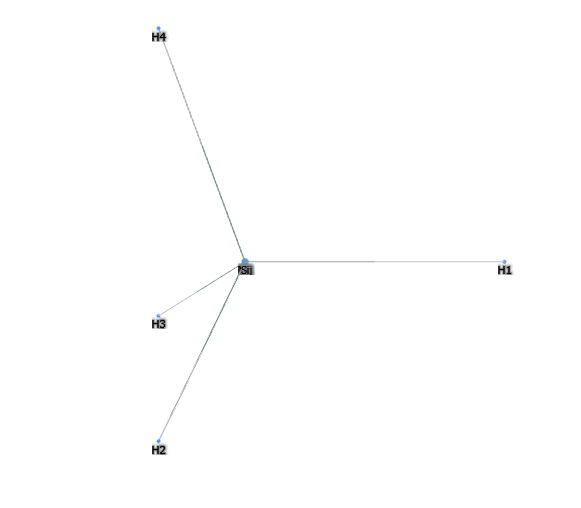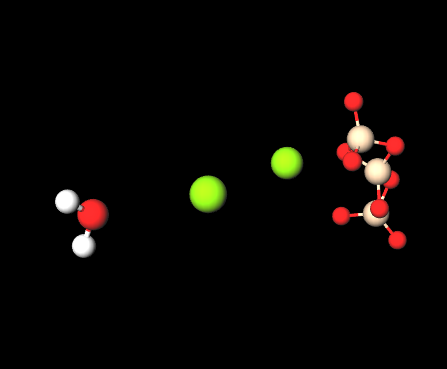Magnesium silicate is an inorganic chemical compound produced by the reaction between an aqueous solution of sodium salt and magnesium. It is formed from magnesium oxide and silicon oxide. It occurs naturally in the USA and India.
It appears as an amorphous white powder that is insoluble in water and alcohol.

What it is used for and where
Food
Ingredient on the European food additives list as E553a with anti-caking and non-stick function (1).
Medical
Magnesium silicate is used in the treatment of gastric and duodenal ulcers and hyperacidity (2).
Cosmetics
Absorbent. Absorbs substances dispersed or dissolved in aqueous solutions, water/oil, oil/water.
Anticaking agent. This compound facilitates free flow and prevents aggregation or clumping of substances in a formulation by reducing the tendency of certain particles to stick together.
Bulking agent. It regulates the water content, dilutes other solids, can increase the volume of a product for better flow, acts as a buffer against organic acids, helps to keep the pH of the mixture within a certain level.
Opacifying agent. It is useful into formulations that may be translucent or transparent to make them opaque and less permeable to light.
Viscosity control agent. It controls and adapts viscosity to the required level for optimal chemical and physical stability of the product and dosage in gels, suspensions, emulsions, solutions.
Safety
EFSA's Panel on Food Additives provided a scientific opinion on the safety of calcium silicate (E552), magnesium silicate (E553a) and talc (E553b) when used as food additives. The Panel noted that the absorption of silicates and talc was very low; there was no indication of genotoxicity or developmental toxicity of calcium and magnesium silicates and talc, and no confirmed cases of renal effects were found in the EudraVigilance database, despite the extensive and long-term use of high doses of magnesium trisilicate up to 4 g/person/day for decades. However, the Panel considered that an accumulation of silicon from calcium silicate in the kidney and liver was reported in rats and that reliable data on the subchronic and chronic toxicity, carcinogenicity and reproductive toxicity of silicates and talc were lacking. Therefore, the Panel concluded that the safety of calcium silicate (E552), magnesium silicate (E553a(i)), magnesium trisilicate (E553a(ii)) and talc (E553b) when used as food additives cannot be evaluated. (3)
Other uses
- adsorbent in chromatography
- highly efficient adsorbent for toxic metal ions
- dry cleaning of biodiesel
- pigment in dispersion paints (3)
Magnesium silicate hydrate
- Molecular Formula MgO3Si hydrate
- Molecular Weight
- CAS 1343-88-0
- UNII 9B9691B2N9
- EC Number 215-681-1
References_____________________________________________________________________
(1) Yapıcı, E., Karakuzu-İkizler, B. and Yücel, S., 2021. Anticaking additives for food powders. Food powders properties and characterization, pp.109-123.
(2) YOKOI, H. and ENOMOTO, S., 1978. The Silicate Structure Analysis of Magnesium Silicate Antacid by the Trimethylsilylation Method. Chemical and Pharmaceutical Bulletin, 26(6), pp.1846-1851.
(3) EFSA Panel on Food Additives and Nutrient Sources added to Food (ANS), Younes, M., Aggett, P., Aguilar, F., Crebelli, R., Dusemund, B., Filipič, M., Frutos, M.J., Galtier, P., Gott, D. and Gundert‐Remy, U., 2018. Re‐evaluation of calcium silicate (E 552), magnesium silicate (E 553a (i)), magnesium trisilicate (E 553a (ii)) and talc (E 553b) as food additives. EFSA Journal, 16(8), p.e05375.
![]() Magnesium silicate
Magnesium silicate 

